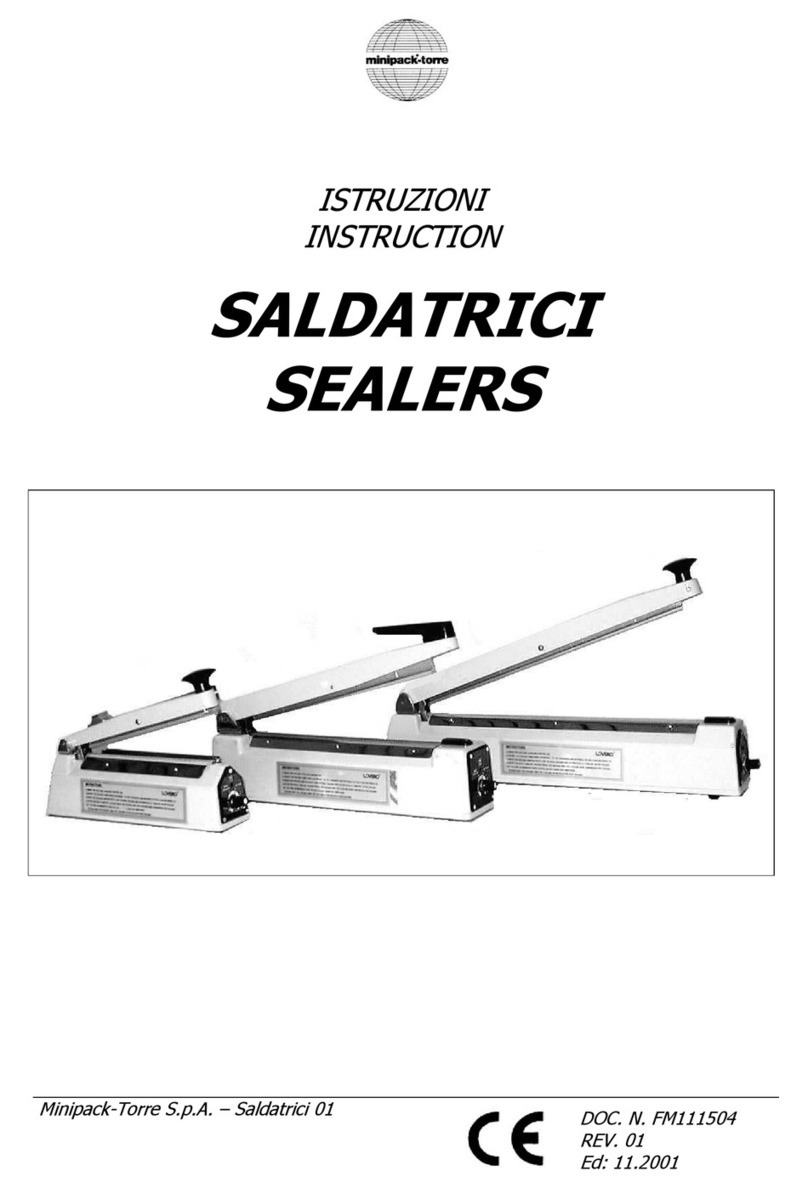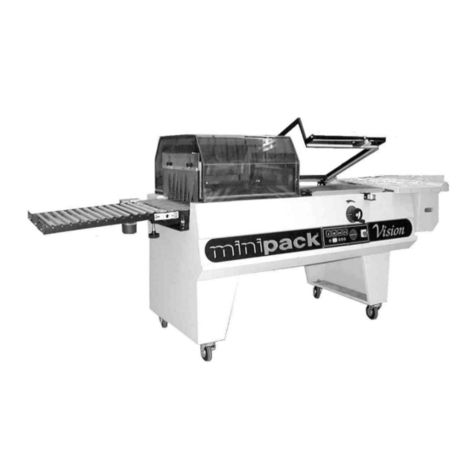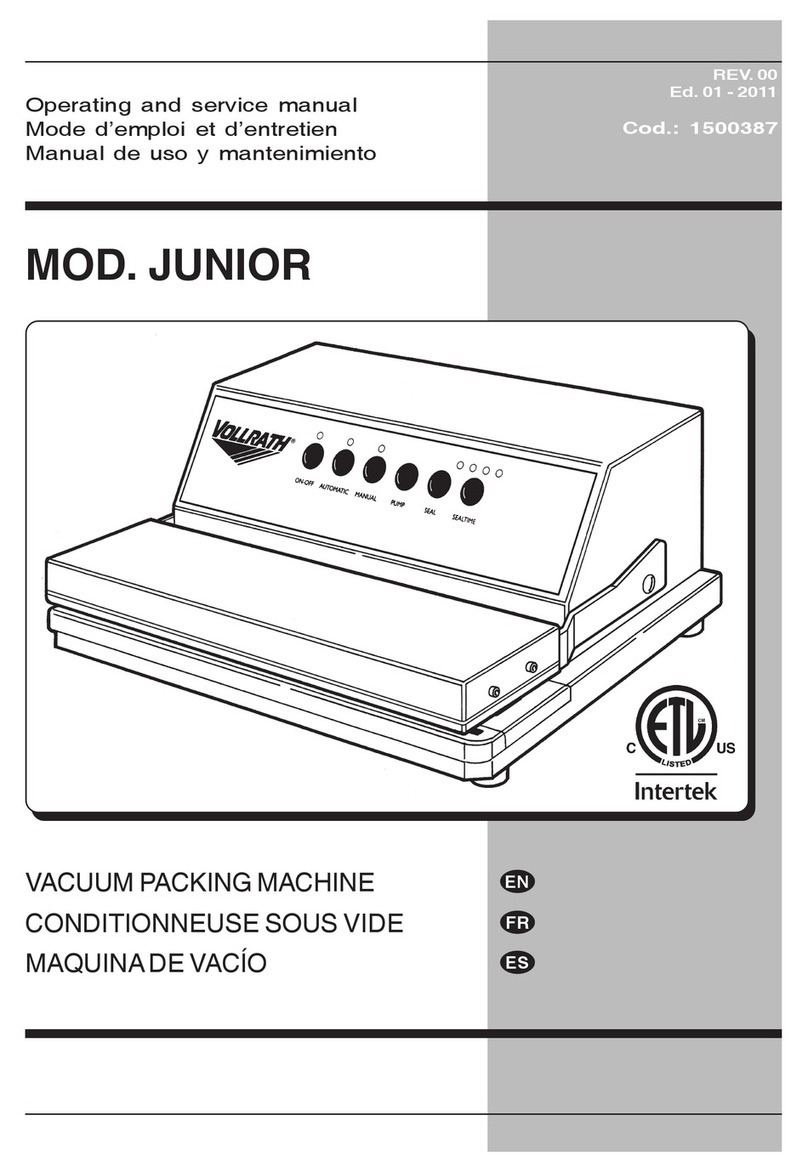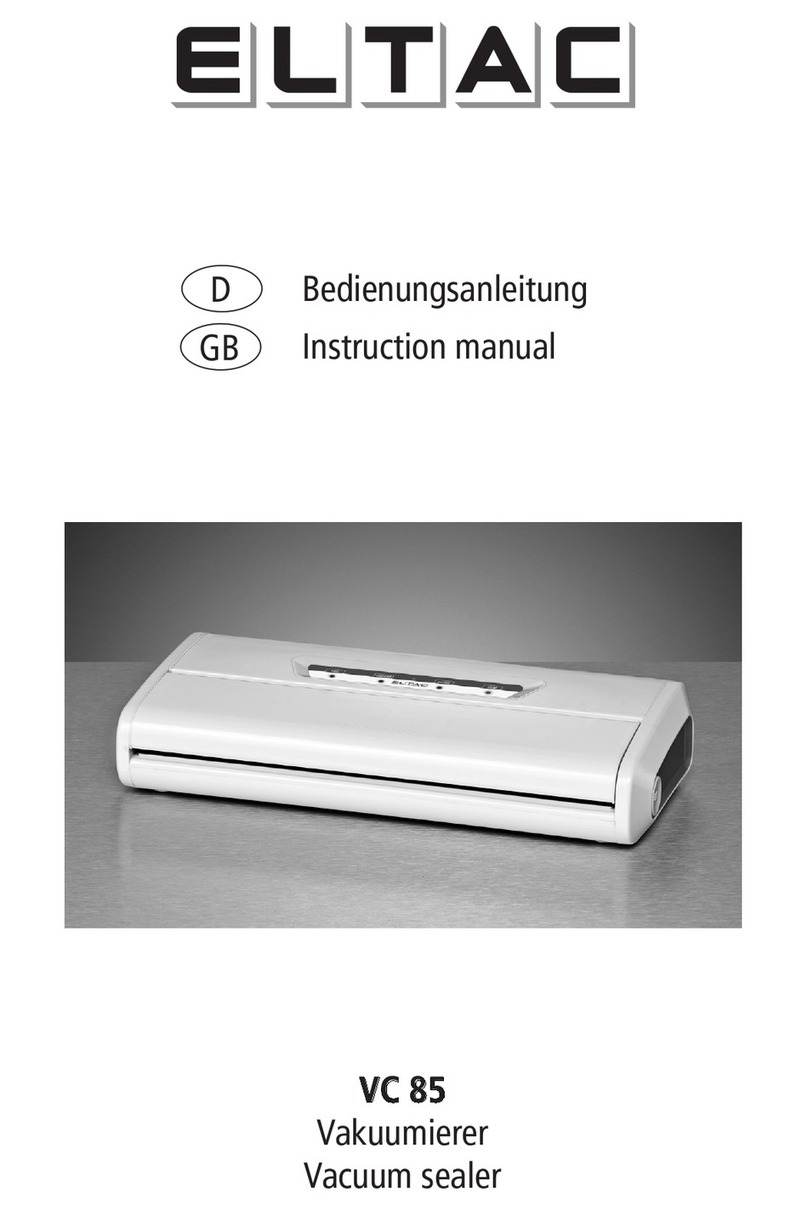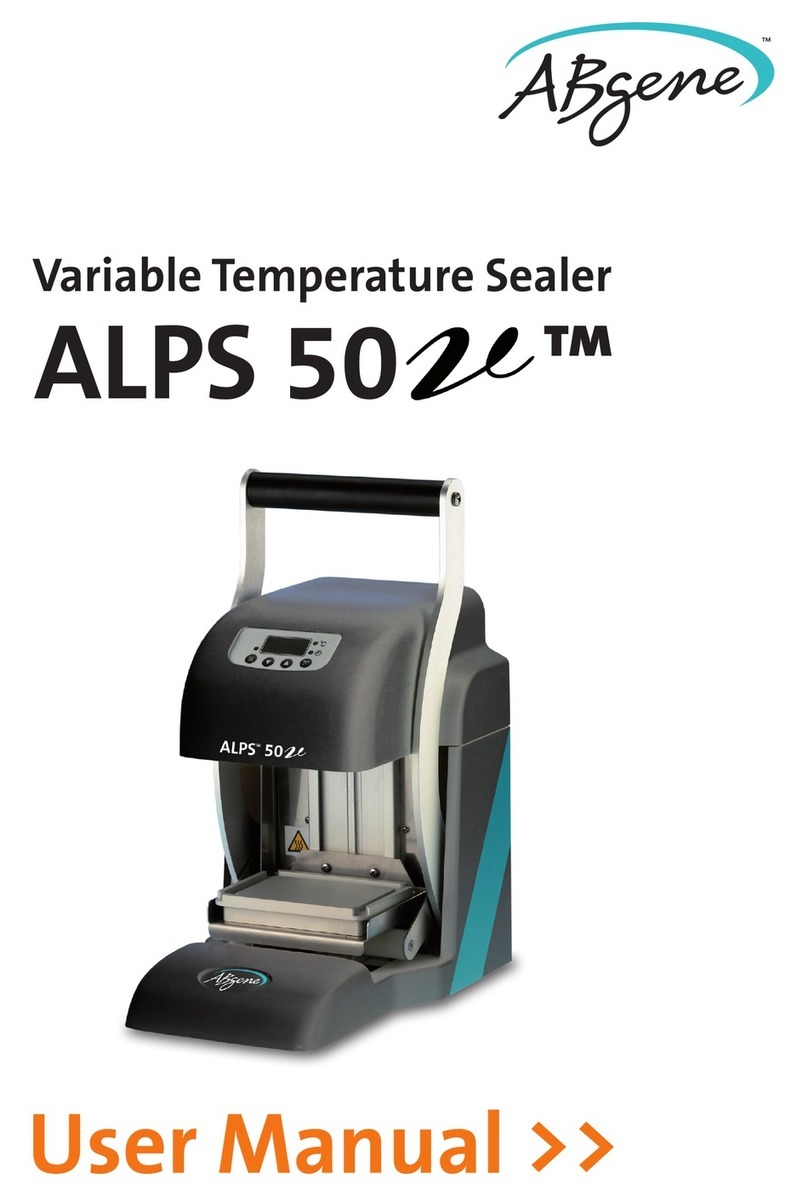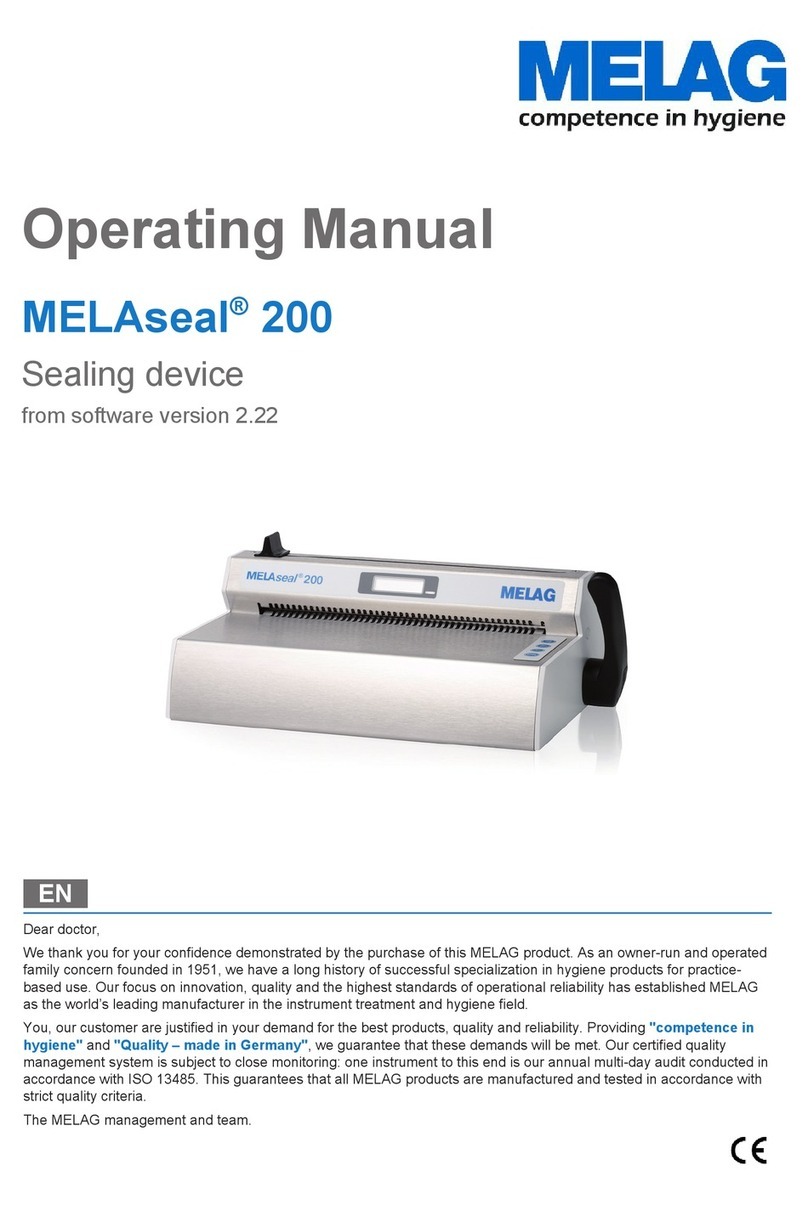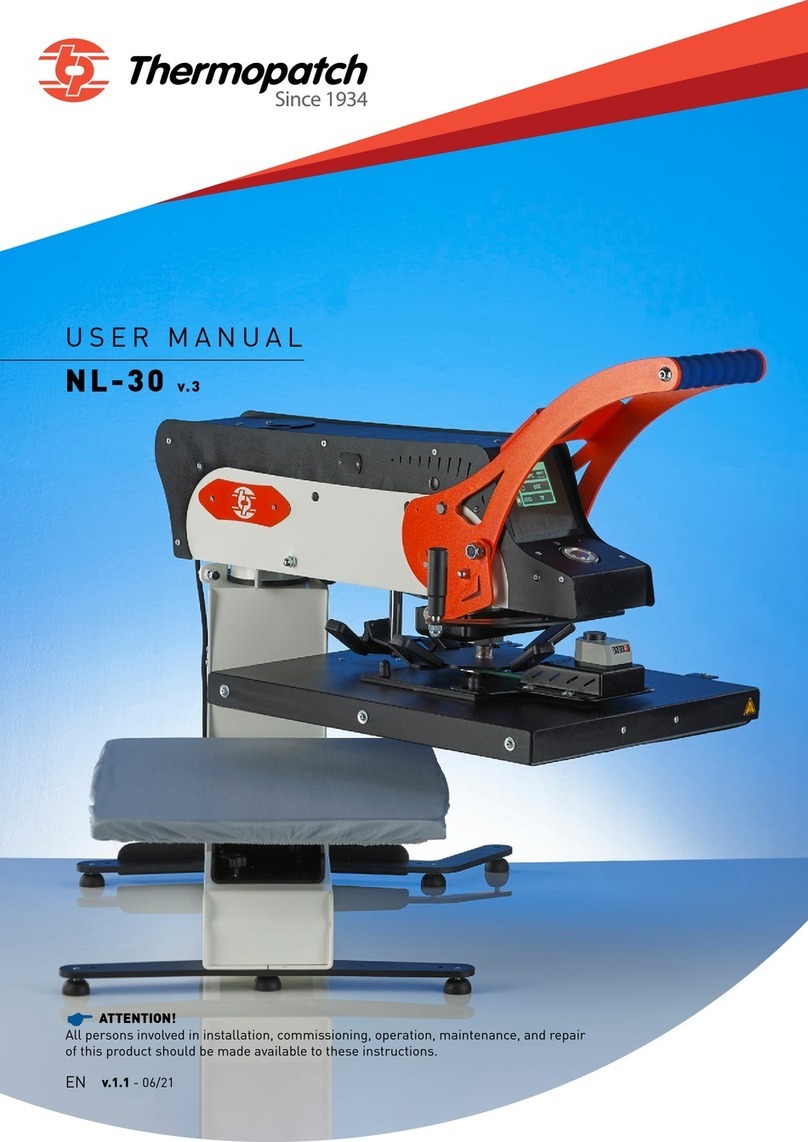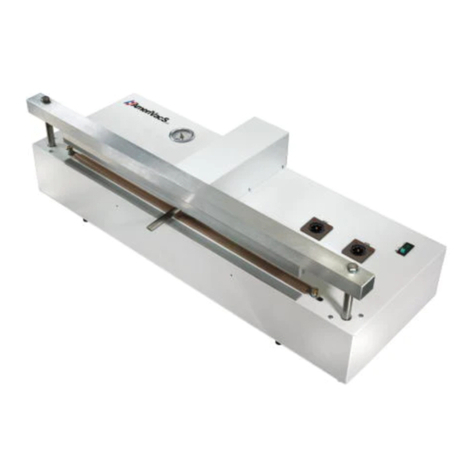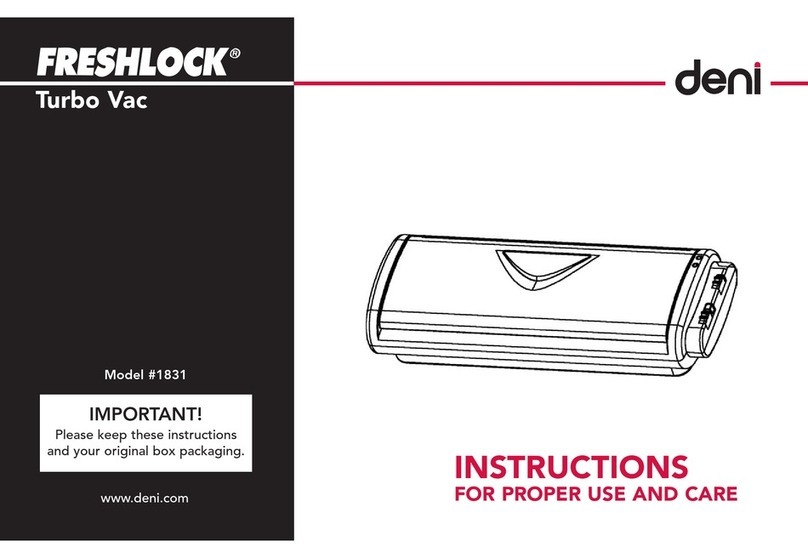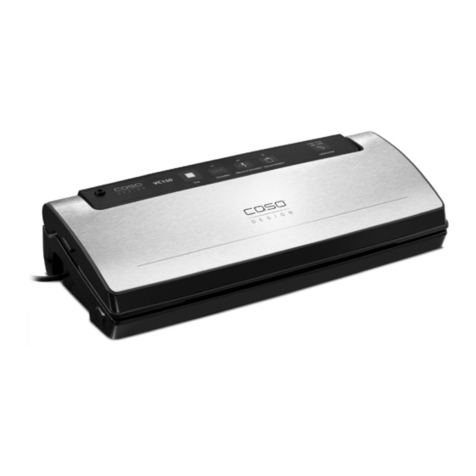Minipack-Torre Media Matic Owner's manual

Minipack-torre S.p.A.
Via Provinciale, 54 - 24044 Dalmine (BG) - Italy
Tel. (035) 563525 – Fax (035) 564945
E-mail:info@ minipack-torre.it
http://www.minipack-torre.it
I ISTRUZIONE PER L’INSTALLAZIONE, L’USO E LA MANUTENZIONE
GB INSTALLATION, OPERATION AND MAINTENANCE
D INSTALLATIONS-, GEBRAUCHS- UND WARTUNGSANLEITUNG
F INSTRUCTIONS POUR L’INSTALLATION, L’EMPLOI ET L’ENTRETIEN
E INSTRUCCIONES PARA LA INSTALACION, USO Y MANTENIMENTO
Media Matic
I LEGGERE ATTENTAMENTE QUESTO LIBRETTO PRIMA DI USARE LA MACCHINA
GB BEFORE USING THE MACHINE PLEASE CAREFULLY READ THE INSTRUCTIONS
D LESEN SIE SICH DIE BEDIENUNGSANLEITUNG BITTE GENAU DURCH, BEVOR SIE DIE MASCHINE BENUTZEN
F NOUS VOUS PRIONS DE BIEN LIRE LE MANUEL D’INSTRUCTIONS AVANT D’UTILISER LA MACHINE
E LEER ATENTAMENTE ESTE MANUAL ANTES DE USAR LA MÁQUINA
IItaliano Pagina 01
GB English Page 10
DDeutsch Seite 19
FFrançais Page 28
EEspañol Página 37
DOC. N. FM111037
REV. 01
ED. 02.2007

1
Indice ITA
Capitolo 1. Introduzione
1.1. Prefazione pagina 02
1.2. Prestazioni della macchina confezionatrice pagina 02
1.3. Identificazione della macchina pagina 02
1.4. Peso e dimensioni dell’imballo pagina 02
1.5. Peso e dimensioni della macchina pagina 02
Capitolo 2. Installazione della macchina
2.1. Trasporto e posizionamento pagina 03
2.2. Condizioni ambientali pagina 03
2.3. Collegamento elettrico pagina 03
Capitolo 3. Regolazione ed approntamento macchina
3.1. Regolazione pagina 03
3.2. Ciclo manuale ed automatico pagina 05
3.3. Inserimento bobina film pagina 05
3.4. Regolazione del nastro trasportatore pagina 05
3.5. Regolazione del flusso d’aria pagina 05
3.6. Regolazione supporto bobina e piatto confezionamento pagina 05
3.7. Esecuzione 1^ saldatura film pagina 05
3.8. Aggancio film all’avvolgitore (dove previsto) pagina 05
3.9. Introduzione dell’oggetto da confezionare pagina 05
3.10. Confezionamento pagina 06
Capitolo 4. Limitazioni e condizioni d’uso della macchina
4.1. Dimensioni max. della confezione pagina 06
4.2. Ciò che non si deve confezionare pagina 06
Capitolo 5. Caratteristiche del film
5.1. ilms da adoperare pagina 06
5.2. Calcolo della fascia A pagina 06
Capitolo 6. Norme di sicurezza
6.1. Avvertimenti pagina 06
Capitolo 7. Manutenzione ordinaria
7.1. Cautele per interventi di manutenzione ordinaria pagina 07
7.2. Pulizia lama saldante pagina 07
7.3. Rimozione sfridi di film pagina 07
7.4. Controllo liquido di raffreddamento pagina 07
7.5. Cambio teflon e gomma pagina 07
7.6. Regolazione delle cammes pagina 08
7.7. Cambio lama saldante pagina 08
7.8. Schema elettrico pagina 08
7.9. Particolari di ricambio pagina 09
7.10.Smontaggio, demolizione e smaltimento residui pagina 09
Capitolo 8. Garanzia
8.1. Certificato di garanzia pagina 09
8.2. Condizioni di garanzia pagina 09
Dichiarazione CE di conformità pagina 46

2
Capitolo 1. Introduzione ITA
1.1. Prefazione
Il presente manuale è redatto nel rispetto della norma UNI 10893 del Luglio 2000. È rivolto a tutti gli utilizzatori al fine di
consentire un corretto uso della macchina. Conservarlo in luogo facilmente accessibile vicino alla macchina e noto a
tutti gli utilizzatori. Il presente manuale è parte integrante della macchina ai fini della sicurezza. Per migliorare la
comprensione precisiamo di seguito i simboli utilizzati.
ATTENZIONE:
Norme antinfortunistiche per l’operatore. Tale avvertimento indica la presenza di pericoli che
possono causare lesioni a chi sta operando sulla macchina.
ATTENZIONE:
Organi caldi. Indica il pericolo di ustioni con rischio di infortunio, anche grave per la persona
esposta.
AVVERTENZA:
Indica la possibilità di arrecare danno alla macchina e/o ai suoi componenti.
Tutti i diritti di riproduzione del presente manuale sono riservati alla ditta costruttrice. La riproduzione, anche parziale, è
vietata a termini di legge. Le descrizioni e le illustrazioni presenti in questo manuale non sono impegnative, di
conseguenza la ditta costruttrice si riserva il diritto di apportare in qualsiasi momento tutte le modifiche che riterrà
opportune. Il presente manuale non può essere ceduto in visione a terzi senza autorizzazione scritta della ditta
costruttrice. La macchina deve essere utilizzata solo per soddisfare le esigenze per cui è stata concepita, ogni altro uso
è da considerarsi “uso improprio”, quindi pericoloso.
Prima di compiere qualsiasi operazione sulla macchina è obbligatorio leggere attentamente tutte le istruzioni del
presente manuale, al fine di evitare possibili danneggiamenti alla macchina stessa, alle persone ed alle cose.
Non è consentito operare in caso di dubbi sulla corretta interpretazione delle istruzioni.
Interpellare il fabbricante per ottenere i necessari chiarimenti.
Al momento della consegna verificare che la macchina sia completa in tutte le sue parti.
Eventuali anomalie dovranno essere presentate immediatamente al fornitore.
La ditta costruttrice declina ogni responsabilità per uso improprio della macchina e/o per danni causati in seguito ad
operazioni non contemplate in questo manuale.
1.2. Prestazioni della macchina confezionatrice
Avete acquistato una macchina dalle caratteristiche e prestazioni eccezionali e Vi ringraziamo per la preferenza
accordataci. Il sistema di confezionamento è unico nel suo genere e si è affermato nel mondo con la presenza di oltre
80000 macchine operanti nel campo dell’imballaggio e del confezionamento.
La validità del concetto tecnologico oltre che la qualità dei componenti e materiali impiegati nel processo produttivo e di
collaudo sono la migliore garanzia di un buon funzionamento e affidabilità nel tempo.
La “Media Matic” è una confezionatrice angolare corredata di tunnel di retrazione.
Le novità sostanziali di questo modello sono da individuare proprio nel tunnel di retrazione, che è un corpo unico con il
resto della macchina. Il tunnel, dotato di regolazioni di temperatura, altezza e velocità, è infatti incorporato in modo da
rendere la macchina più compatta e versatile, adatta a prestazioni in serie di media grandezza.
La macchina può arrivare ad eseguire fino a 750 confezioni/ora.
1.3. Identificazione della macchina
Per qualsiasi comunicazione con il costruttore, citare sempre il modello della macchina e il numero di matricola indicati
sulla targhetta applicata nella parte posteriore della macchina (figura 1.3. pag.47).
1.4. Peso e dimensioni dell’imballo
a = mm900 b = mm2500 c = mm1510 Peso = Kg343 (figura 1.4. pag.47).
1.5. Peso e dimensioni della macchina
a = mm730 b = mm2780 c = mm1400 Peso = Kg287 (figura 1.5. pag.47).

3
Capitolo 2. Installazione della macchina ITA
2.1. Trasporto e posizionamento
Nel trasporto e nel posizionamento della macchina si raccomanda di manovrare con molta cautela!
Nella movimentazione della macchina utilizzare guanti di protezione.
!Tagliare con la forbice la reggia (avendo cura di proteggersi gli occhi con degli occhiali) e sfilare il cartone (figura
2.1.A pag.47).
!Togliere la scatola contenente la rulliera (Y).
!Svitare le 4 viti di fissaggio al pallet.
!Sollevare la macchina con un carrello elevatore.
!Posizionare le 4 ruote sulla macchina.
!Togliere la scatola (X) contenente i pannelli di chiusura e fissarli alle gambe.
!Posizionare la rulliera agganciandola al nastro trasportatore (figura 2.1.B pag.47).
2.2. Condizioni ambientali
!Posizionare la macchina accertandosi che sia livellata sul pavimento, in un ambiente adatto, privo di umidità,
materiali infiammabili, gas, esplosivi.
!Lasciare uno spazio minimo di 200mm attorno alla macchina, per non ostruire le prese d’aria (figura 2.2. pag.47).
!Bloccare la macchina, una volta ottenuto il corretto posizionamento, agendo sul freno delle ruote.
Condizioni consentite negli ambienti in cui é collocata la macchina:
!Temperatura da + 5°C a + 40°C
!Umidità relativa da 30% a 90% senza condensazione.
L’illuminazione del locale di utilizzo deve essere conforme alle leggi vigenti nel paese in cui è installata la macchina e
deve comunque essere uniforme e garantire una buona visibilità, per salvaguardare la sicurezza e la salute
dell’operatore.
GRADO DI PROTEZIONE DELLA MACCHINA = IP20
IL RUMORE AEREO PRODOTTO DALLA MACCHINA È INFERIORE A 70 dB
2.3. Collegamento elettrico
RISPETTARE LE NORME PER LA SICUREZZA SUL LAVORO!
Se la macchina non è dotata della spina di alimentazione utilizzare una spina adeguata ai valori di tensione
e amperaggio descritti nella targhetta dati e comunque conforme alle normative vigenti nel paese
d’installazione.
È OBBLIGATORIA LA MESSA A TERRA! (figura 2.3. pag.47).
Prima di effettuare il collegamento elettrico assicuratevi che la tensione di rete corrisponda al voltaggio indicato sulla
targhetta applicata nella parte posteriore della macchina e che il contatto di terra sia conforme alle norme di sicurezza
vigenti. In caso di dubbi sulla tensione di rete contattate l’ente locale distributore dell’energia elettrica.
Capitolo 3. Regolazione ed approntamento macchina ITA
3.1. Regolazione
AInterruttore generale
BSpia saldatura
CSpia tempo avanzamento nastro
DSpia tempo di pausa
ESpia velocità nastro forno
FSpia temperatura
PPulsante di selezione programmi
D1 Display. Visualizza le funzioni selezionate e i relativi dati di impostazione
SPulsante di selezione variabili
G1 Pulsante “DECREMENTA”. Riduce i valori delle funzioni impostate
G2 Pulsante “INCREMENTA”. Aumenta i valori delle funzioni impostate
HPulsante reset
D2 Display conta pezzi
(figura 3.1.A pag.47).

4
Capitolo 3. Regolazione ed approntamento macchina ITA
3.1. Regolazione
CARATTERISTICHE SCHEDA ELETTRONICA
La macchina ha 5 programmi selezionabili:
N° Programma Caratteristiche Programma
P1
P2
P3, P4, P5
Solo taglio
Taglio + avanzamento nastro (senza retrazione)
Programmi completi
Il programma più completo è composto da 6 variabili modificabili (qualora una variabile non fosse impostabile,
chiaramente non comparirà):
Variabile Campo Caratteristiche Campo
1. Tempo saldatura
2. Tempo pausa telaio giù
3. Tempo pausa ciclo aut.
4. Velocità nastro tunnel
5. Tempo nastro saldatura
6. Temperatura polmone
0 ÷ 2.7
0 ÷ 9
0.0
÷
9.9
00
÷
99
0.0
÷
3.0
00
÷
99
valori espressi in secondi
2 decimi di secondo per punto
valori espressi in secondi
valori espressi in secondi
corrisponde a 200°
÷
398°C (2°C per punto)-(valore medio 75)
La macchina è dotata di un contapezzi che visualizza il numero di saldature effettuate sul display (D2).
Questo valore è resettabile a 0 in qualsiasi momento tramite il pulsante reset (H).
FASE 1 = ACCENSIONE DELLA MACCHINA
Ruotare l’interruttore generale (A) nella posizione 1.
Sul display (D1) compare l’anomalia “- -“ (figura 3.1.B pag.47) in quanto la macchina viene spedita con il telaio di
saldatura abbassato. Per portare il telaio in posizione di partenza ed eliminare di conseguenza l’anomalia, premere il
pulsante di emergenza (O) (figura 3.1.C pag.47). Sbloccare poi lo stesso pulsante di emergenza (O) ruotandolo verso
destra.
Sul display (D1) compare il nr. di programma attivo.
Nei programmi P3,P4,P5 l’unità del tunnel (resistenze, ventola, nastro), non vengono attivate immediatamente dopo la
selezione dei programmi sopra elencati, ma con un comando manuale. Alla selezione di uno di questi programmi il
display non mostrerà “P3” ma “L3”. È quindi necessario premere il tasto (G2) per la loro attivazione.
FASE 2 = CONTROLLO SENSO DI ROTAZIONE
Premere il pulsante di marcia (M) (figura 3.1.C pag.47).
Verificare che il nastro trasportatore ruoti nel senso indicato in figura (figura 3.1.C pag.47).
In caso contrario invertire due delle tre fasi della spina di alimentazione (figura 3.1.D pag.48).
N.B.: Il controllo del senso di rotazione va eseguito ogni volta che si cambia presa di alimentazione.
FASE 3 = SELEZIONE PROGRAMMI
Per selezionare il n° di programma premere il pulsante (P).
FASE 4 = PROGRAMMAZIONE VARIABILI
Con il pulsante (S) si scorrono le variabili del programma scelto e con i pulsanti (G1) e (G2) si modificano i valori
memorizzati. Una volta impostato il valore desiderato premere il tasto (S) e rilasciarlo, si accenderà il led della funzione
successiva. Impostare il valore della variabile come già descritto.
Per convalidare le modifiche premere il pulsante (S) fino a far comparire sul display il n° di programma.
Il tempo di pausa telaio giù é una variabile modificabile che non ha un led associato e pertanto viene indicato con una
“r” sul display sinistro, mentre il display destro indica il tempo impostato.
Al termine di tutte le variabili programmabili il display mostrerà nuovamente il codice del programma appena editato (es.
P1).
N.B.: Se durante la programmazione viene premuto il fine corsa SQ1 l’apparecchio esce dalla programmazione e il
programma selezionato va immediatamente in esecuzione rimostrando sul display il numero del programma.
FASE 5 = ESECUZIONE
Prima di usare la macchina attendere che arrivi alla temperatura impostata segnalata dallo spegnimento della spia (F).
Eseguite tutte le regolazioni la macchina é pronta per procedere al confezionamento.
FASE 6 = SPEGNIMENTO
Se si è nei programmi P3,P4,P5, l’uscita dall’unità tunnel avviene premendo il pulsante (G1) (il display
tornerà a mostrare L3, L4, L5). Questa operazione (uscita dall’unità tunnel) è da eseguire prima di
spegnere la macchina.
Dopo la disinserzione del riscaldamento la ventola ed il nastro del forno continuano a funzionare per un
certo tempo (10min.) prima di spegnersi, in modo da attendere il raffreddamento del forno.

5
Capitolo 3. Regolazione ed approntamento macchina ITA
3.1. Regolazione
In caso di “ANOMALIA ” sul display (D1) compaiono le seguenti sigle:
E 1 La macchina è stata accesa con il telaio di saldatura abbassato.
Alzare il telaio.
E 2 La macchina è stata accesa col pulsante (S) premuto.
Rilasciare il pulsante. Se permane la segnalazione di errore controllare il funzionamento del pulsante.
E 4 La temperatura ha superato i 450°C oppure la sonda è interrotta.
Il ripristino avviene riavviando la macchina.
E 6 Segnalazione rottura fine corsa esclusione sicurezza (sempre chiuso). Occorre controllare il corretto
funzionamento del fine corsa esclusione sicurezza e quindi spegnere e riaccendere la macchina.
E 7 Blocco unità tunnel per intervento termico motore ventola o relè inverter.
Contattare il servizio di assistenza.
- - Telaio non in posizione all’accensione.
Premere il pulsante di emergenza per far risalire il telaio. A telaio risalito la segnalazione scompare.
3.2. Ciclo manuale ed automatico
La macchina può lavorare sia in ciclo manuale che automatico (figura 3.2. pag.48).
Per eseguire un solo ciclo di lavoro ruotare il selettore (Q) in posizione “MAN.” e premere il pulsante di marcia (M)
Per lavorare in ciclo automatico ruotare il selettore (Q) in posizione “AUT.” e premere il pulsante di marcia (M).
!La macchina è dotata di un PULSANTE DI EMERGENZA (O) che premuto la blocca
istantaneamente, riportando il telaio di saldatura in posizione di partenza.
!La macchina è inoltre dotata di un sistema di sicurezza automatico sul telaio di saldatura che
interviene nel caso la discesa del telaio stesso venga ostacolata, riportando il telaio in posizione di
partenza.
3.3. Inserimento bobina film
!Inserire la bobina di film sul rullo (1) bloccandola mediante i coni centratori (2) (figura 3.3.A pag.48).
!Posizionare il rullo sul supporto bobina (3).
!Passaggio attraverso i microforatori (4) (figura 3.3.B pag.48).
!Passaggio del lembo inferiore del film sotto il piatto di confezionamento (5) (figura 3.3.C pag.48).
!Passaggio del lembo superiore del film sopra il piatto di confezionamento (5).
3.4. Regolazione nastro trasportatore
Regolare l’altezza del nastro trasportatore agendo sull’apposito volantino (figura 3.4.A pag.48).
N.B.: Per una buona confezione il nastro trasportatore deve essere posizionato in modo che la saldatura del film si trovi
a metà dell’altezza della confezione.
Regolare le tendine all’ ingresso del tunnel agendo sulle apposite manopole (6) in modo che le stesse siano a livello del
nastro del tunnel (figura 3.4.B pag.48).
3.5. Regolazione del flusso d’aria
È possibile regolare il flusso dell’aria calda sul prodotto da confezionare agendo sulle manopole (7) (figura 3.5.A
pag.48). La rotazione delle manopole (7) determina la posizione dei deflettori (8), che dirigono il flusso dell’aria calda
nella direzione voluta per ottenere la migliore retrazione (figura 3.5.B pag.49).
3.6. Regolazione supporto bobina e piatto di confezionamento
Il supporto bobina (3) e il piatto di confezionamento (5) devono essere regolati in funzione della larghezza dell’oggetto
da confezionare, lasciando circa 1-2 cm di spazio tra l’oggetto ed il bordo di saldatura (figura 3.6. pag.49).
3.7. Esecuzione 1^ saldatura film
Per eseguire la 1^ saldatura portare il film come indicato in figura (figura 3.7. pag.49).
Ruotare il selettore (Q) in posizione “MAN.” e premere il pulsante di marcia (M).
La macchina entrerà automaticamente in funzione e realizzerete la 1^ saldatura sul lato sinistro del film.
Con la mano destra aiutate il distacco del film dalla lama saldante.
3.8. Aggancio film all’avvolgitore (dove previsto)
Eseguire ora un numero di cicli sufficente a formare una striscia di film di scarto (figura 3.8.A pag.49).
Passarla intorno al rullino di rinvio (9) e al rullino di comando (10) ed agganciarla all’avvolgitore (11) (figura 3.8.B
pag.49). Ora la macchina è pronta per procedere al confezionamento.
3.9. Introduzione dell’oggetto da confezionare
Sollevare con la mano sinistra il bordo del film sul piatto di confezionamento (figura 3.9.A pag.49).
Introdurre con la mano destra il prodotto nel film e farlo scorrere verso sinistra fino a depositarlo sul nastro
trasportatore, lasciando circa 1-2 cm. di spazio tra il prodotto ed il telaio interno di saldatura (figura 3.9.B pag.49).

6
Capitolo 3. Regolazione ed approntamento macchina ITA
3.10. Confezionamento
Premere il pulsante di marcia (M) (figura 3.10. pag.49). Il telaio di saldatura si abbasserà automaticamente per
eseguire il taglio e la saldatura. Alla riapertura del telaio, la confezione avanzerà verso il tunnel liberando la zona di
saldatura per un nuovo ciclo. Se la macchina é in posizione di ciclo automatico, riprenderà il ritmo impostato dalla
programmazione.
Capitolo 4. Limitazioni e condizioni d’uso della macchina ITA
4.1. Dimensioni max. della confezione
a = mm 550 b = mm 380 c = mm 100 (figura 4.1. pag.49).
N.B.: le misure indicate nella tabella si riferiscono alla misura max. della singola dimensione.
Per la misura max della confezione (b x c) bisogna comunque fare riferimento al capitolo 5.2., dove si vede che, la
somma di (b + c) é comunque uguale alla larghezza della bobina del film meno 100 mm.
4.2. Ciò che non si deve confezionare
E’ assolutamente vietato confezionare i seguenti tipi di prodotti per evitare di danneggiare in modo permanente la
macchina, oltre che provocare rischi di infortuni all’operatore addetto:
•Prodotti bagnati e instabili
•Liquidi di qualsiasi tipo e densità in contenitori fragili
•Materiali infiammabili ed esplosivi
•Bombolette con gas a pressione o di qualsiasi tipo
•Polveri sciolte e volatili
•Eventuali materiali e prodotti non previsti che possano in qualche modo essere pericolosi per
l’utente e provocare danni alla macchina stessa
Capitolo 5. Caratteristiche del film ITA
5.1. Films da adoperare
La macchina può lavorare con tutti i films termoretraibili, con spessore da 15 a 50 micron sia di tipo tecnico che
alimentare. Per garantire i migliori risultati è consigliato l’utilizzo dei films da noi commercializzati.
Le speciali caratteristiche dei nostri films (anche con disegni e scritte personalizzate del cliente) danno garanzie di
affidabilità sia dal lato della corrispondenza alle normative di legge vigenti, che dal lato sicurezza di ottimo
funzionamento delle nostre macchine.
Si raccomanda di consultare le schede tecniche e di sicurezza dei films utilizzati e di attenersi alle
prescrizioni descritte!
A = mm600 MAX D = mm350 MAX d = mm77 (figura 5.1. pag.49).
5.2. Calcolo della fascia A
Fascia A = b + c + 100mm (figura 5.2. pag.50).
Capitolo 6. Norme di sicurezza ITA
6.1. Avvertimenti
NON PERMETTERE L’USO DELLA MACCHINA A PERSONALE NON ADDESTRATO!
Durante le fasi di lavoro porre attenzione a tutte le parti calde della macchina che possono
raggiungere temperature tali da provocare ustioni.
Durante il funzionamento della macchina è vietato fumare!

7
Capitolo 6. Norme di sicurezza ITA
6.1. Avvertimenti
!Prima di inserire il ciclo automatico assicurarsi di avere effettuato tutte le regolazioni.
!Tutte le regolazioni della macchina vanno eseguite con il selettore (Q) in posizione “MAN.” (figura 6.1.A pag.50).
In caso di blocco della macchina o per fermarla durante il ciclo automatico premere il PULSANTE DI
EMERGENZA (O) (figura 6.1.A pag.50).
!Non toccare la lama saldante (19) subito dopo la saldatura, oltrepassando con la mano la barriera di protezione
antinfortunistica (12). Possibilità di scottature dovute al residuo calore sulla lama saldante (19) (figura 6.1.B pag.50).
!Non procedere nella saldatura nel caso di rottura della lama saldante (19). Provvedere immediatamente alla sua
sostituzione (figura 6.1.B pag.50).
!Non toccare le parti calde della macchina durante la fase di riscaldamento. Possibilità di scottature (figura 6.1.C
pag.50).
!Non toccare il nastro trasportatore quando è in movimento (figura 6.1.D pag.50).
!Assicurarsi che la bobina di film sia alloggiata correttamente nella sua sede (31) (figura 6.1.E pag.50).
Capitolo 7. Manutenzione ordinaria ITA
7.1. Cautele per interventi di manutenzione ordinaria
LA MANUTENZIONE ORDINARIA DEVE ESSERE EFFETTUATA DA PERSONALE QUALIFICATO
OPPORTUNAMENTE ISTRUITO.
Prima di effettuare le operazioni di manutenzione spegnere la macchina agendo sull’interruttore
generale, togliere la spina dalla presa di rete e attendere il raffreddamento della macchina!
Durante le operazioni di manutenzione si consiglia di utilizzare guanti di protezione!
7.2. Pulizia lama saldante
!Rimuovere con un panno asciutto i residui di film che si possono depositare sulla lama saldante; effettuare questa
operazione subito dopo una saldatura in modo che i residui, ancora caldi, possano essere asportati con facilità
(figura 7.2.A pag.50).
!Lubrificare periodicamente la lama saldante con il grasso fornito in dotazione con la macchina (figura 7.2.B pag.50).
7.3. Rimozione di sfridi di film plastico e vari
È molto importante provvedere con frequenza alla pulizia interna del tunnel, in modo da asportare tutti i residui di film
dei prodotti confezionati (figura 7.3.A pag.51).
Prima di eseguire questa operazione, attendere che il tunnel si sia adeguatamente raffreddato!
Quando la bobina dell’avvolgitore automatico (15) è piena, rimuovere il film svitando la manopola (17) e togliendo il
disco (16) (figura 7.3.B pag.51).
7.4. Controllo liquido di raffreddamento
Controllare ogni 6 mesi il livello del liquido di raffreddamento togliendo il carter (34) e svitando il tappo (35) (figura 7.4.A
pag.51). Verificare che l’astina del tappo sia bagnata dal liquido per circa 2 cm., altrimenti aggiungere una miscela di
acqua e liquido anticongelante (10%) (figura 7.4.B pag.51).
7.5. Cambio teflon e gomma
Quando i riscontri in teflon (13) sono troppo usurati, sostituirli con quelli di ricambio facendo molta attenzione alla loro
applicazione, lineare e piana (figura 7.5. pag.51). Pulire con detergente la gomma (14) prima dell’applicazione del nastro
di teflon autoadesivo. Se anche la gomma (14) risulta deteriorata provvedere alla sua sostituzione nel modo seguente:
1. togliere la gomma vecchia
2. pulire la sede che la contiene
3. mettere alcune gocce di colla nella sede stessa
4. inserire la nuova gomma in modo lineare
5. pulire la gomma con detergente
6. applicare il nastro di teflon autoadesivo

8
Capitolo 7. Manutenzione ordinaria ITA
7.6. Regolazione delle cammes
La regolazione delle cammes deve essere eseguita solo dal personale autorizzato!
Per accedere alle cammes è necessario smontare il pannello (38) posto sul retro della macchina (figura 7.6.A pag.51).
Le cammes sono 2 e regolano (figura 7.6.B pag.51):
1. La discesa del telaio di saldatura e di conseguenza la pressione dello stesso sulla lama saldante.
2. L’apertura massima del telaio di saldatura e la partenza del nastro trasportatore.
La regolazione si effettua allentando la vite e ruotando la camme nella posizione idonea.
Attenzione: nella regolazione delle cammes procedere gradualmente con piccoli spostamenti.
7.7. Cambio lama saldante
Per sostituire la lama saldante (19) seguire questa procedura (figura 7.7. pag.51):
!Togliere tensione alla macchina
!Svitare le 3 viti (20)-(21)-(22)
!Togliere la lama saldante vecchia
!Pulire la sede e se necessario sostituire il teflon isolante (23) del morsetto centrale
!Inserire la lama saldante nuova partendo dal morsetto centrale e stringere la vite (21)
!Rifilare la lama saldante nuova a filo del foro dei pistoncini (24) e (25)
!Completare l’inserimento della lama saldante in tutta la sede
!Spingere a fondo il pistoncino posteriore (25) verso la lama saldante in modo che questa entri nel foro dello stesso
e stringere la vite (22)
!Inserire un attrezzo (es. cacciavite) nell’asola (18) e spingere a fondo il pistoncino anteriore (24) verso la lama
saldante in modo che questa entri nel foro dello stesso e stringere la vite (20)
!Rifilare il teflon sporgente dal morsetto centrale
!Assicurarsi che la lama saldante (19) sia posizionata bene ed in tensione
7.8. Schema elettrico
(figura 7.8. pag.52/53).
Q1 Interruttore generale SQ1 Finecorsa discesa telaio
F1 Fusibili lama saldante / resistori 10.3X38 SQ2 Finecorsa salita telaio
F2 Fusibili motore ventola / nastro / telaio 10.3X38 SQ3 Finecorsa esclusione sicurezza
F3 Fusibile trasformatore ausiliario 10.3X38 SQ5 Finecorsa sicurezza
F4 Fusibile motori ventilatore / pompa 5X20 KM1 Contattore taglio
FU Fusibile scheda 5X20 KM2 Contattore resistori forno
EH1 Resistenza di taglio KM3 Contattore ventola forno
EH2 Resistori forno KM4 Contattore nastro
EH3 Resistori forno KM5 Contattore salita telaio
EH4 Resistori forno KM6 Contattore discesa telaio
M1 Motore ventola KM7 Contattore accessori
M2 Motore nastro saldatura SB0 Pulsante di emergenza
M3 Motore automazione telaio SB1 Pulsante di marcia
M4 Motore nastro forno SA1 Selettore manuale
M5 Motore ventilatore YA Elettromagnete saldatura
M6 Motore pompa SP Pedale (optional)
M7 Motore avvolgitore BT1 Termocoppia
T1 Trasformatore di taglio K1 Modulo di potenza
T2 Trasformatore ausiliario SK1 Scheda comando
SQ Finecorsa avvolgitore TS1 Inverter

9
Capitolo 7. Manutenzione ordinaria ITA
7.9. Particolari di ricambio
Codice Denominazione particolare
S08A0404 Rivestimento teflon
FE385602 Lama saldante
S0K00306 Morsetto porta lama centrale
S0K00302 Morsetto porta lama posteriore
S0K00301 Morsetto porta lama anteriore
S03A0606 Rotellina con cava completa
S03A0605 Rotellina con aghi completa
FE380015 (380/415V)
FE380019 (200/208V)
FE380020 (230V)
Resistenza
FE240070 (230/380/415V)
FE240071 (200/208V) Motore ventola tunnel
7.10. Smontaggio, demolizione e smaltimento residui
ATTENZIONE!
Le operazioni di smontaggio e demolizione devono essere affidate a personale specializzato a tali attività e
dotato delle competenze meccaniche ed elettriche necessarie a lavorare in condizioni di sicurezza.
Procedere nel seguente modo:
1. scollegare la macchina dalla rete di alimentazione elettrica
2. smontare i componenti
Ciascun rifiuto deve essere trattato, smaltito o riciclato in base alla classificazione ed alle procedure previste
dalla legislazione vigente nel paese di installazione.
Il simbolo indica che questo prodotto non deve essere trattato come rifiuto domestico.
Assicurando che il prodotto venga correttamente eliminato, si faciliterà la prevenzione di potenziali
conseguenze negative per l’ambiente e la salute dell’uomo, che potrebbero altrimenti essere causate da
un inappropriato trattamento del rifiuto di questo prodotto.
Per informazioni più dettagliate riguardo il riciclaggio di questo prodotto, contattare il venditore del
prodotto, o in alternativa il servizio di post vendita o l’appropriato servizio di trattamento dei rifiuti.
Capitolo 8. Garanzia ITA
8.1. Certificato di garanzia
La Garanzia ha validità 12 mesi dalla data di installazione alle condizioni riportate sul libretto d’istruzioni. Compilare il
retro della cartolina in ogni sua parte, strappare lungo la linea e spedire.
8.2. Condizioni di garanzia
La garanzia è valida 12 mesi e decorre dalla data di installazione della macchina. La garanzia consiste nella
sostituzione o riparazione gratuita di tutte quelle parti riscontrate da noi difettose per anomalie di materiali. Le riparazioni
o sostituzioni avvengono normalmente presso la casa costruttrice con l’addebito all’acquirente delle spese di trasporto o
manodopera. Qualora le riparazioni o sostituzioni vengano eseguite presso la sede dell’acquirente, quest’ultimo sarà
tenuto a pagare le spese di viaggio, trasferta e manodopera. Le prestazioni di garanzia vengono eseguite
esclusivamente a cura della casa costruttrice o dal rivenditore autorizzato. Per avere diritto a prestazioni di garanzia
inviare alla casa costruttrice od al rivenditore autorizzato il pezzo difettoso, perché sia effettuata la riparazione o
sostituzione. La riconsegna di tale pezzo riparato o sostituito, rientrerà nell’adempimento delle operazioni di garanzia. La
garanzia viene annullata:
1. per il mancato immediato invio postale del CERTIFICATO DI GARANZIA al momento dell’acquisto, debitamente
compilato e firmato entro 20 giorni.
2. per la errata installazione, la inadeguata alimentazione, negligenza d’uso e manomissione da parte di persone non
autorizzate.
3. per modifiche effettuate sulla macchina senza il consenso scritto della casa.
4. qualora la macchina non sia più proprietà del primo acquirente
La casa costruttrice declina a termine di legge ogni responsabilità per danni a persone o cose qualora venga
effettuata un’errata installazione o collegamento alla rete di alimentazione elettrica o esclusione della messa a
terra od in caso di manomissioni della macchina stessa. La casa costruttrice si riserva di approntare modifiche
e cambiamenti secondo esigenze tecniche e di funzionamento.

10
Index GB
Chapter 1. Foreword
1.1. Preface page 11
1.2. Performances of packaging machine page 11
1.3. Machine identification page 11
1.4. Package weight and dimensions page 11
1.5. Machine weight and dimensions page 11
Chapter 2. Machine installation
2.1. Transport and positioning page 12
2.2. Environmental conditions page 12
2.3. Electrical connections page 12
Chapter 3. Machine adjustment and setting up
3.1. Adjustment page 12
3.2. Manual and automatic cycle page 14
3.3. Film reel insertion page 14
3.4. Conveyor belt adjustment page 14
3.5. Air flow adjustment page 14
3.6. Reel support and packaging plate adjustment page 14
3.7. Execution of 1^ film sealing page 14
3.8. Film binding on rewinder (where expected) page 14
3.9. Introducing the object to be wrapped page 14
3.10. Packaging page 15
Chapter 4. Limits and conditions in the use of machine
4.1. Max. packing sizes page 15
4.2. Items which must not be packed page 15
Chapter 5. Film features
5.1. Films to be used page 15
5.2. Band A calculation page 15
Chapter 6. Safety standards
6.1. Warnings page 15
Chapter 7. Ordinary maintenance
7.1. Precautions for ordinary maintenance interventions page 16
7.2. Sealing blade cleaning page 16
7.3. Plastic film removal page 16
7.4. Control of cooling liquid page 16
7.5. Rubber and teflon replacement page 16
7.6. Adjustment of the cams page 17
7.7. Changing the sealing blade page 17
7.8. Wiring diagram page 17
7.9. Spare parts page 18
7.10. Disassembling, demolition and elimination of residual page 18
Chapter 8. Guarantee
8.1. Certificate of guarantee page 18
8.2. Guarantee conditions page 18
EC declaration of conformity page 46

11
Chapter 1. Foreword GB
1.1. Preface
This manual has been drawn up in compliance with the UNI10893 standard dated July 2000. It is meant for all users in
order to enable them to use the machine correctly. Keep it in a place which can be easily accessed in the proximity of
the machine and which is known to all users. This manual is an integral part of the machine for safety reasons. We wish
to specify the symbols in use here below in order to improve their understanding.
ATTENTION:
Accident prevention rules for the operator. This warning indicates the presence of dangers which
can injure the person operating on the machine.
ATTENTION:
Hot members. It shows the danger of burning, thus involving the risk of a serious accident for the
exposed person.
WARNING:
It indicates the possibility of damaging the machine and/or its components.
All reproduction rights of this manual are reserved to the manufacturer. Partial or complete reproduction is forbidden as
provided by the law. Descriptions and pictures provided on this manual are not binding. Therefore the manufacturer,
reserves the right of making any change considered necessary. This manual cannot be transferred for viewing to third
parties without authorisation in writing of the manufacturing company. The machine must be used only for the purpose it
was built. Any other use shall be considered as “illegitimate use” and therefore dangerous. Before carrying out any
operation on the machine it is compulsory to read carefully all instructions provided on this manual, in order to avoid
possible damage to the machine, to people and property.
Do not operate in case of doubts on the correct interpretation of the instructions.
Contact the manufacturer in order to obtain the necessary explanation.
Upon delivery check that the machine is complete in all parts.
Possible anomalies shall be immediately reported to the manufacturer.
The manufacturing company disclaims any responsibility in case of machine illegitimate use and/or in case of damages
resulting form operations carried out on the machine that are not mentioned in this manual.
1.2. Performances of packaging machine
You have bought a machine with outstanding features and performance and we thank you very much for your
confidence in choosing it. The system is unique in its own kind and has achieved worldwide success with more than
80000 units operating in the of packaging and wrapping.
The technological concept underlining its design, as well as the components and materials used in the manufacturing
and testing process are the best assurance of proper operation and long-lasting liability.
“Media Matic” is an “L” sealer packaging machine equipped with shrinking tunnel.
Which represents a real novelty ab it is incorporate in machine structure.
Such a tunnel is height and speed adjustable,equipped with temperature adjustment; the machine is more compact and
versatile as it is included in its bodywork. This machine can pack up to 750 pieces per hour.
1.3. Machine identification
In every communication with the Manufacturer, always mention the model and the serial number specified on the plate
on the rear part of the machine (figure 1.3. page 47).
1.4. Package weight and dimensions
a = mm900 b = mm2500 c = mm1510 Weight = Kg343 (figure 1.4. page 47).
1.5. Machine weight and dimensions
a = mm730 b = mm2780 c = mm1400 Weight = Kg287 (figure 1.5. page 47).

12
Chapter 2. Machine installation GB
2.1. Transport and positioning
It is recommended to handle with great care during transport and positioning!
Use protection gloves while handling the machine.
!Cut the strap with scissors (make sure you protect your eyes by wearing glasses) and withdraw the cardboard
(figure 2.1.A page 47).
!Remove the cardboard containing the roller way (Y).
!Unscrew the 4 fastening screws of the pallet.
!Lift the machine by using a fork lift.
!Place the 4 wheels onto the machine.
!Remove the box (X) containing the closing panels and fix them to the legs.
!Position the roller way, coupling it to the conveyor belt (figure 2.1.B page 47).
2.2. Environmental conditions
!Place the machine in a suitable environment free from humidity, gases, explosives, combustible materials.
!Leave a minimal space of 200mm around the machine so that not to obstruct air outlets (figure 2.2. page 47).
!Once the correct height is abtained, block the machine by means of the wheel brakes.
Working environmental conditions:
!Temperature from + 5°C to + 40°C
!Relative humidity from 30% to 90%, without condensation
The lighting of the operation room shall comply with the laws in force in the country where the machine is installed.
However, it shall be uniform and provide for good visibility in order to safeguard the operator’s safety and health.
MACHINE SAFETY FACTOR = IP20
THE AERIAL NOISE MADE BY THE MACHINE IS LOWER THAN 70 dB
2.3. Electrical connections
OBSERVE HEALTH AND SAFETY REGULATIONS!
If the machine is not equipped with the power supply plug, use a plug that is suitable for the voltage and
amperage values described by the rating plate and that can comply with the rules in force in the installation
country.
GROUNDING OF THE UNIT IS OBLIGATORY! (figure 2.3. page 47).
Before executing electrical connections, make sure the mains voltage matches the one on the plate on machine rear
and that the ground contact complies with the safety rules in force.
In case of doubts about the mains voltage, contact the local public supply Company.
Chapter 3. Machine adjustment and setting up GB
3.1. Adjustment
AMain switch
BSealing warning light
CWarning light of belt advancing time
DPause warning light
EWarning light of over belt speed
FTemperature warning light
PPrograms selection button
D1 Display. Displays selected functions and relative settings
SVariables selection switch
G1 Button “DECREASE”. Reduces set function values
G2 Button “INCREASE”. Increases set function values
HReset button
D2 Piece counter display
(figure 3.1.A page 47).

13
Chapter 3. Machine adjustment and setting up GB
3.1. Adjustment
ELECTRONIC BOARD FEATURES
The machine is equipped with 5 selectionable programs:
Program no. Program features
P1
P2
P3, P4, P5
Cutting only
Cutting + belt advancing (no shrinking)
Complete programs
Each program is composed by 6 variables which can be modified (in case it is not possible to set one of them, such a
variable will obviously not appear on the display):
Variable Field Field features
1. Time for sealing
2. Pause time for lowered frame
3. Pause time for automatic cycle
4. Tunnel belt speed
5. Sealing belt time
6. Temperature
0 ÷ 2.7
0 ÷ 9
0.0÷ 9.9
00 ÷ 99
0.0 ÷ 3.0
00 ÷ 99
values expressed in seconds
two tenth-seconds values each point
values expressed in seconds
values expressed in seconds
corresponds to 200°
÷
398°C (2°C each point)-(medium value 75)
The machine is equipped with a piece counter to show on display (D2) the number of sealings.
Such a value can be put to zero at any time through reset button (H).
PHASE NR. 1 = SWITCHING THE MACHINE ON
Turn the main switch (A) into pos. 1.
The anomaly “- -“ appears on display (D1) (figure 3.1.B page 47) because the machine is shipped with the sealing frame
down. In oder to bring the frame back to its start position and to remove the anomaly, press the emergency pushbutton
(O) (figure 3.1.C page 47). Then turn it to the right to release the emergency pushbutton (O).
The active programme no. appears on display (D1).
The tunnel units (heaters, fan, belt) are not activated in programmes P3, P4, P5 just after the selection of the
programmes listed above, but by means of a manual control. When selecting one of these programs, display will show
”L3” instead of “P3”; it is then necessary to press button (G2) to activate them.
PHASE NR. 2 = CONTROL OF DIRECTION OF ROTATION
Press the start button (M) (figure 3.1.C page 47).
Check the conveyor belt for correct rotation, which shall match the direction that is shown in the figure (figure 3.1.C
page 47).
Otherwise invert two of the three phases of the electrical plug (figure 3.1.D page 48).
N.B.: The control of direction of rotation should be carried out each time you change the electrical plug.
PHASE NR. 3 = PROGRAMS SELECTION
Push button (P) to select the number of the program.
PHASE NR. 4 = VARIABLES PROGRAMMING
Through button (S) it is possible to look through the variables of the selected program, while through buttons (G1)-(G2)
the stored values can be modified. Once the value has been set, push (S) button and then release it; the LED of the
next function will light up. Set the value of the variables as previously described. To validate modifications, press button
(S) until the number of the program appears on the display. Pause time ”lowered frame” can be modified; there is not a
LED indicating this variable which is shown with an “r” on the left display, while the right one shows the time which has
been set. At the end of all variables to be adjusted, the display will show the code of the program just chosen (for
example P1).
N.B.: In case during programming the SQ1 limit switch is being pressed, the unit quits the scheduling, the selected
program is executed and the display shows the number of the program.
PHASE NR. 5 = PERFORMANCE
Before using the machine, wait until the adjusting temperature is reached. This is signalled by the warning light (F).
Once all adjustments have been made, the machine is ready to start working.
PHASE NR. 6 = POWER OFF
If you are in programmes P3,P4,P5, exit from tunnel unit is made pressing button (G1) (display will show
L3, L4, L5). Such an operation (exit from tunnel) has to be made before switching the machine off.
After heating has been disconnected, the tunnel belt and fan keep on functioning for a certain time
(about 10 min.) before switching off, so to wait for the tunnel to cool down.

14
Chapter 3. Machine adjustment and setting up GB
3.1. Adjustment
In case of “ANOMALY” the display (D1) will show as follows:
E 1 Machine has been switched on when sealing frame was lowered.
Lift sealing frame up.
E 2 Machine has been switched on when (S) button was pressed. Release button. In case the error signalling still
persists, check the correct functioning of the button.
E 4 Temperature is higher than 450°C or feeler has been cut off.
Switch the machine on to reset.
E 6 The limit switch to cut out security is broken (it is always closed ).Check the correct functioning of the limit switch
to cut out security, then switch the machine off and on again.
E 7 Tunnel blocked for thermic intervention of fan motor or inverter relay.
Contact the assistance service.
-- Sealing frame not in proper position when switching machine on. Press emergency pushbutton to lift hood. Once
it has been lifted,signalling will disappear.
3.2. Manual and automatic cycle
The machine can be operated with a manual as well as with an automatic cycles (figure 3.2. page 48).
To carry out only one operating cycle rotate the selector (Q) to the “MAN.” position and press the start button (M).
To operate the automatic cycle rotate the selector (Q) to the “AUT.” position and press the start button (M).
!The machine is equipped with an EMERGENCY PUSHBUTTON (O) which blocks it immediately
when pressed, bringing the sealing frame into start position.
!The machine has also an automatic safety system on the welding frame which intervenes in case the
lowering of the frame is hindered, bringing the frame back in the start position.
3.3. Film reel insertion
!Insert the roll of film on the roller (1) and block it through the centering cones (2) (figure 3.3.A page 48).
!Position the roller on the film reel support (3).
!Run through the micropunches (4) (figure 3.3.B page 48).
!Run the film lower layer under the packaging plate (5) (figure 3.3.C page 48).
!Run the film upper layer over the packaging plate (5).
3.4. Conveyor belt adjustment
Adjust the height of the conveyor belt with the special handwheel (figure 3.4.A page 48).
N.B.: In order to get a good packaging the conveyor belt should be positioned in such a way, that the film welding is
made at half the packaging height.
Adjust curtains acting placed on tunnel inlet on the proper knobs to get them at the same level of tunnel belt (figure
3.4.B page 48).
3.5. Air flow adjustment
It is possible to adjust the air flow on the product to pack by acting on the knobs (7) (figure 3.5.A page 48).
The rotation of handles (7) determines the position of the flaps (8) which drive the hot air flow into the desired direction
so to obtain the best shrinking (figure 3.5.B page 49).
3.6. Reel support and packaging plate adjustment
The reel support (3) and the packaging plate (5) must be adjusted according to the width of the article to be packaged,
leaving a space of about 1-2 cm between the article and the sealing edge (figure 3.6. page 49).
3.7. Execution of 1^ film sealing
To carry out the 1^ sealing move the film, as shown in the figure (figure 3.7. page 49).
Rotate the selector (Q) to “MAN.” position and press the start button (M).
The machine will automatically start operating, and the first sealing will be performed on the film’s left side.
With the right hand detach the film from the sealing blade.
3.8. Film binding on rewinder (where expected)
Carry out a number of cycles sufficient to make a strip of scrap film (figure 3.8.A page 49).
Guide this film strip around the transmission roll (9)and the driving roll (10) and bind it with the coiler (11) (figure 3.8.B
page 49). The machine is now ready to start the packaging.
3.9. Introducing the object to be wrapped
Lift the film edge on the packaging plate with your left hand (figure 3.9.A page 49).
Introduce the product with your right hand in the film and move if to the left until it settles on the conveyor belt leaving
about 1-2 cm space between the product and the outer edge of the sealing frame (figure 3.9.B page 49).

15
Chapter 3. Machine adjustment and setting up GB
3.10. Packaging
Press the ON push-button (M) (figure 3.10. page 49). The sealing frame will automatically lower to cut and weld the film.
When the frame opens again, the packed product will be fed towards the tunnel. Thus, the welding area will be released
and ready to start a new sealing cycle. If the machine is set to operate in automatic mode, it will restart work according
to the rhythm set by programming.
Chapter 4. Limits and conditions in the use of machine GB
4.1. Max. packing sizes
a = mm 550 b = mm 380 c = mm 100 (figure 4.1. page 49).
N.B.: max. dimensions shown on above scheme are referring to the max. dimension of the single package.
Refer to chapter 5.2. to get max. dimension of package (b x c); the addition of (b + c) is equal to film roll width 100 mm.
4.2. Items which must not be packed
The below listed products must absolutely not be wrapped to avoid damages to the machine and serious injuries to the
operator in charge:
•Wet and unstable products
•Liquids of any kind and density in fragile containers
•Flammable and explosive materials
•Pressurised gas cylinder of any kind
•Bulk and volatile powders
•Any materials and products not listed but which might harm operator and cause damages to the
machine.
Chapter 5. Film features GB
5.1. Films to be used
The machine can work with all thermoshrinkable films, from 15 to 50 microns in thickness, of a technical and food type.
To guarantee the best results, it is recommended to use the films marketed by us.
The special features of our films (which may be customised with drawings and text) assure their outstanding reliability,
with regard both to compliance with laws in force and to an excellent machine performance.
It is recommended to refer to the technical and safety sheets of the films in use and to observe the
corresponding instructions!
A = mm600 MAX D = mm350 MAX d = mm77 (figure 5.1. page 49).
5.2. Band A calculation
Band A = b + c + 100mm (figure 5.2. page 50).
Chapter 6. Safety standards GB
6.1. Warnings
THE MACHINE CAN NOT BE USED BY UNTRAINED PERSONNEL!
During the work phases pay attention to all hot parts of the machine. The temperature they can
reach is so high that it can cause burns.
It is forbidden to smoke when the machine is working!

16
Chapter 6. Safety standards GB
6.1. Warnings
!Before starting the automatic cycle, make sure that all necessary adjustments have been made.
!All adjustments of the machine will be made by the selector (Q) in “MAN.” position (figure 6.1.A page 50).
In case of blocking of the machine or in order to stop it during the automatic cycle press EMERGENCY
PUSHBUTTON (O) (figure 6.1.A page 50).
!Do not touch the sealing blade (19) soon after sealing by reaching beyond the safety guard (12). Danger of burns
due to residual heat on the sealing blade (19) (figure 6.1.B page 50).
!Do not keep on sealing in case the sealing blade breaks (19). Replace it at once (figure 6.1.B page 50).
!Do not touch the machine hot components during the heating phase. Danger of burns (figure 6.1.C page 50).
!Do not touch the conveyor belt when it is in motion (figure 6.1.D page 50).
!Make sure the film roll is properly lodged (31) (figure 6.1.E page 50).
Chapter 7. Ordinary maintenance GB
7.1. Precautions for ordinary maintenance interventions
ORDINARY MAINTENANCE, MUST BE EXECUTED BY QUALIFIED STAFF APPROPRIATELY TRAINED.
Before proceeding to maintenance, switch the machine off and disconnect it by operating on the
master switch and wait for the machine to cool down!
It is recommended to use protection gloves during maintenance operations!
7.2. Sealing blade cleaning
!Using a dry cloth, wipe off the residues clinging to the sealing blade: do this at once after sealing since they are
easier to remove when still warm (figure 7.2.A page 50).
!Periodically lubrificate the sealing blade with the grease supplied with the machine (figure 7.2.B page 50).
7.3. Plastic film removal
It is very important to periodically clean the tunnel inside so to remove all scraps (figure 7.3.A page 51).
Wait for the tunnel to cool down properly before cleaning it!
When the bobbin of the automatic coiler (15) is full, remove the film by unscrewing the knob (17) and taking away the
disk (16) (figure 7.3.B page 51).
7.4. Control of cooling liquid
Check the level of the cooling fluid once every 6 months. To do so, remove the guard (34) and unscrew the plug (35)
(figure 7.4.A page 51).
Check that the rod is wetted by the liquid at about 2 cm height, otherwise add a mixture of water and antifreeze
liquid(10%) (figure 7.4.B page 51).
7.5. Rubber and teflon replacement
When the Teflon-stripes (13) are worn out, replace them with spare parts, paying attention that the application is linear
and even (figure 7.5. page 51). Before applying the teflon self-adhesive strip clean the rubber part (14) with a detergent.
If also the rubber (14) is damaged too, replace it as follows:
1. remove the old rubber
2. clean its housing
3. apply some drops of glue in the housing
4. insert the new rubber in a linear way
5. clean the rubber with a detergent
6. apply the self-adhesive teflon-strip

17
Chapter 7. Ordinary maintenance GB
7.6. Adjustment of the cams
The adjustment of the cams must only be carried out by authorised personnel!
It is necessary to disassemble the panel (38) at the back of the machine in order to get access to the cams (figure 7.6.A
page 51).
There are 2 cams which control (figure 7.6.B page 51):
1. Sealing frame lowering and its pressure on the sealing blade.
2. Sealing frame max opening and the start of the conveyor blade.
The adjustment is made by loosening the screw (39) and rotating the cam in the right position.
Attention: for the adjustment of the cams, shift them gradually!
7.7. Changing the sealing blade
To replace the sealing blade (19) follow this procedure (figure 7.7. page 51):
!Disconnect power to the machine
!Unscrew the three screws (20), (21), (22)
!Remove the old sealing blade
!Clean the housing and if necessary replace the insulating teflon (23) of the central clamp
!Insert the new sealing blade starting from the central clamp and tighten the screw (21)
!Trim the new sealing blade according to the holes of the pistons (24) and (25)
!Complete the insertion if the sealing blade in the whole housing
!Push the rear piston completely onwards (25) towards the sealing blade to make it enter the hole of the piston itself
and then tighten screw (22)
!Insert a tool (for example a screwdriver) in hole (18) and push front piston towards the sealing blade to enter the
hole of the piston itself, then tighten screw (20)
!Trim the teflon projecting from the central clamp
!Make sure that the sealing blade (19) is properly positioned and tight.
7.8. Wiring diagram
(figure 7.8. page 52/53).
Q1 Main switch SQ1 Frame lowering limit switch
F1 Sealing blade / heaters fuse 10.3X38 SQ2 Frame lifting limit switch
F2 Fan / belt / frame motor fuse 10.3X38 SQ3 Safety device cutting out limit switch
F3 Auxiliary transformer fuse 10.3X38 SQ5 Safety limit switch
F4 Ventilator / pump motor fuse 5X20 KM1 Cutting contactor
FU Board fuse 5X20 KM2 Heaters contactor
EH1 Cutting resistance KM3 Fan contactor
EH2 Heater KM4 Sealing belt contactor
EH3 Heater KM5 Frame descent contactor
EH4 Heater KM6 Frame rise contactor
M1 Fan motor KM7 Accessories contactor
M2 Belt motor SB0 Emergency pushbutton
M3 Frame drive motor SB1 Start button
M4 Belt oven motor SA1 Manual selector
M5 Ventilator motor YA Sealing magnet
M6 Pump motor SP Foot pedal
M7 Winder motor BT1 Thermocouple
T1 Cut transformer K1 Electronic control board
T2 Auxiliary transformer SK1 Control board
SQ Winder limit switch TS1 Inverter

18
Chapter 7. Ordinary maintenance GB
7.9. Spare parts
Code Item description
S08A0404 Teflon liner
FE385602 Sealing blade
S0K00306 Complete central terminal
S0K00302 Complete rear terminal
S0K00301 Front blade holder clamp
S03A0606 Complete slotted microperforator
S03A0605 Complete needles microperforator
FE380015 (380/415V)
FE380019 (200/208V)
FE380020 (230V)
Heaters
FE240070 (230/380/415V)
FE240071 (200/208V) Fan motor
7.10. Disassembling, demolition and elimination of residuals
ATTENTION!
All operations about disassembling and demolition must be done by qualified personnel with mechanical
and electrical expertise required to work in security conditions.
Proceed as follows:
1. disconnect machine from power mains
2. disassemble components
All wastes must be treated, eliminated or recycled according to their classification and to the procedures in
force established by the laws in force in the country the equipment has been installed.
The symbol indicates that this product shall not be treated as household waste.
By assuring that the product will be properly disposed of, you will facilitate the prevention of potential
negative effects for the environment and the man’s health, which might be otherwise caused by the
improper waste treatment of this product.
For more detailed information about the recycling of this product, please contact the product seller or, as
an alternative, the after-sales service or the corresponding waste treatment service.
Chapter 8. Guarantee GB
8.1. Certificate of guarantee
The guarantee runs for 12 months after the installation date under the conditions set forth on the instruction manual. Fill
in the card with all data requested,tear out along the perforations and send in.
8.2. Guarantee conditions
The guarantee runs for 12 months and goes into force on the installation date of the machine. The guarantee covers
free replacement or repair of any parts due to defects arising from faulty material. The repairs or replacement are
usually carried out at the manufactures, with transport or workmanship at buyer’s charge. If the repair or replacement is
carried out at the buyer’s place, he shall bear the travelling, transfer and workmanship charges. Work under guarantee
can be carried out exclusively by the manufacturer or by the authorised dealer. In order to be entitled to repairs under
the guarantee, the faulty part must be sent for repair or replacement to the manufacturer or his authorised dealer. The
return of such repaired or replaced part will be considered to be the performance of the guarantee.
The guarantee is voided:
1. in case of failure to mail the CERTIFICATE OF GUARANTEE, duly filled in and signed, with in 20 days after the date
of purchase.
2. in case of inappropriate installation, power supply, misuse and mishandling by unauthorised persons.
3. in case of changes made to the machine without prior agreement in writing by the manufacturers.
4. if the machine is no longer the property of the first buyer.
The manufacturer decline any responsibility for damage to persons or things in case of inappropriate
installation or connection to the power mains or omission of connection to earth or in case of any mishandling
of the machine. The manufacturer undertake to carry out any variations and changes made necessary by
technical and operating requirements.

19
Inhaltsverzeichnis D
Kapitel 1. Einleitung
1.1. Vorwort Seite 20
1.2. Leistungseigenschaften der Verpackungsmachine Seite 20
1.3. Beschreibung der Maschine Seite 20
1.4. Gewicht und Abmessungen der Verpackung Seite 20
1.5. Gewicht und Abmessungen des Geräts Seite 20
Kapitel 2. Aufstellung der Maschine
2.1. Beförderung und Positionierung Seite 21
2.2. Umweltbedingungen Seite 21
2.3. Elektrischer Anschluß Seite 21
Kapitel 3. Regelung und Bereitstellung der Maschine
3.1. Regulierung Seite 21
3.2. Der manuelle und automatische arbeitskreislauf Seite 23
3.3. Einstellung der Schweißplatte Seite 23
3.4. Die Regulierung des Förderbandes Seite 23
3.5. Regelung der Luftströmung Seite 23
3.6. Die regulierung des spulenträgers und des Verpackungsflachstabes Seite 23
3.7. Durchführung der ersten Schweissung Seite 23
3.8. Wie der film an die Aufwickler angehängt werden muß (wenn vorgesehen) Seite 23
3.9. Einführen des Verpackungsgutes Seite 23
3.10. Verpacken Seite 24
Kapitel 4. Gebrauchsbeschränkungen und Gebrauchsbedingungen der Maschine
4.1. Maximaldimensionen der Packung Seite 24
4.2. Was nicht verpackt werden darf Seite 24
Kapitel 5. Folieneingeschaften
5.1. Die zu verwendenden Folie Seite 24
5.2. Wie der A-streifen berechnet werden muss Seite 24
Kapitel 6. Sicherheitsmassnahmen
6.1. Warnungen Seite 24
Kapitel 7. Wartung der Maschine
7.1. Maßnahmen, die getroffen werden müssen bevor Wartungsarbeiten durchgefürt werden Seite 25
7.2. Reinigung der schweißenden Klinge Seite 25
7.3. Die entfernung von Abfällen des plastischen film Seite 25
7.4. Die prüfung der höhe der abkühlungsflüssigkeit Seite 25
7.5. Wie Teflon und Gummi ersetzt werden müssen Seite 25
7.6. Die Regulierung der Nocken Seite 26
7.7. Auswechseln der Schweißklinge Seite 26
7.8. Das Schaltbild Seite 26
7.9. Ersatzteile Seite 27
7.10. Demontage, abbau und entsorgung der rückstände Seite 27
Kapitel 8. Garantiezeit
8.1. Garantieschein Seite 27
8.2. Garantiebedingungen Seite 27
EG Konformitätserklärung Seite 46
Other manuals for Media Matic
1
Table of contents
Languages:
Other Minipack-Torre Food Saver manuals
